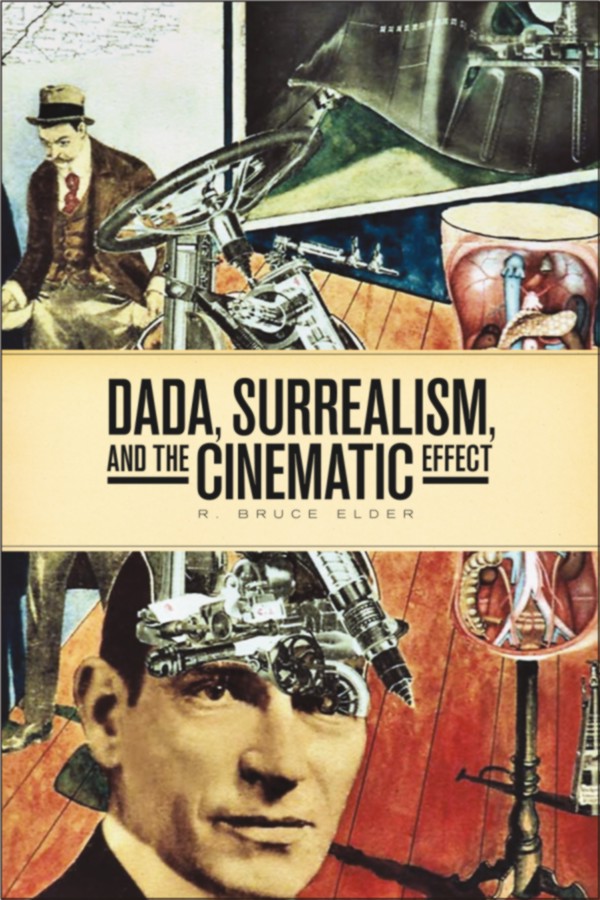R. Bruce Elder: Dada, Surrealism, and the Cinematic Effect (2013)
Filed under book | Tags: · alchemy, art history, avant-garde, chance, cinema, collage, consciousness, dada, dreams, film, film history, language, mathematics, occultism, sexuality, spiritualism, surrealism, theory

“This book deals with the early intellectual reception of the cinema and the manner in which art theorists, philosophers, cultural theorists, and especially artists of the first decades of the twentieth century responded to its advent. While the idea persists that early writers on film were troubled by the cinema’s lowly form, this work proposes that there was another, largely unrecognized, strain in the reception of it. Far from anxious about film’s provenance in popular entertainment, some writers and artists proclaimed that the cinema was the most important art for the moderns, as it exemplified the vibrancy of contemporary life.
This view of the cinema was especially common among those whose commitments were to advanced artistic practices. Their notions about how to recast the art media (or the forms forged from those media’s materials) and the urgency of doing so formed the principal part of the conceptual core of the artistic programs advanced by the vanguard art movements of the first half of the twentieth century. This book, a companion to the author’s previous, Harmony & Dissent, examines the Dada and Surrealist movements as responses to the advent of the cinema.”
Publisher Wilfrid Laurier University Press, Waterloo, 2013
Film and Media Studies series
ISBN 9781554586257, 1554586259
x+765 pages
Reviews: John W. Locke (Canadian J of Film Studies 2014), Robin Walz (Canadian J of History 2014), Bart Testa (U Toronto Quarterly 2015).
PDF (8 MB, updated on 2019-12-14)
EPUB (added on 2019-12-14)
Siegfried Zielinski: Deep Time of the Media: Toward an Archaeology of Hearing and Seeing by Technical Means (2002–) [EN, ES]
Filed under book | Tags: · alchemy, art, cinema, electricity, machine, magic, mathematics, media, media archeology, networks, perception, religion, telegraphy, theatre, time, video, vision

“Siegfried Zielinski argues that the history of the media does not proceed predictably from primitive tools to complex machinery; in Deep Time of the Media, he illuminates turning points of media history—fractures in the predictable—that help us see the new in the old.
Drawing on original source materials, Zielinski explores the technology of devices for hearing and seeing through two thousand years of cultural and technological history. He discovers the contributions of ‘dreamers and modelers’ of media worlds, from the ancient Greek philosopher Empedocles and natural philosophers of the Renaissance and Baroque periods to Russian avant-gardists of the early twentieth century. ‘Media are spaces of action for constructed attempts to connect what is separated,’ Zielinski writes. He describes models and machines that make this connection: including a theater of mirrors in sixteenth-century Naples, an automaton for musical composition created by the seventeenth-century Jesuit Athanasius Kircher, and the eighteenth-century electrical tele-writing machine of Joseph Mazzolari, among others.”
Originally published as Archäologie der Medien: Zur Tiefenzeit des technischen Hörens und Sehens, Rowohlt, Reinbek bei Hamburg, 2002.
Foreword by Timothy Druckrey
Translated by Gloria Custance
Publisher MIT Press, 2006
ISBN 0262240491, 9780262240499
375 pages
Reviews: Simon Werrett (Technology and Culture, 2007), Digital Creativity (2007), Simone Natale (Canadian Journal of Communication, 2012), Stephanie Lam (n.d.).
Deep Time of the Media: Toward an Archaeology of Hearing and Seeing by Technical Means (English, trans. Gloria Custance, 2006, 10 MB, updated on 2020-3-24)
Arqueología de los Medios. Hacia el tiempo profundo de la visión y la audición técnica (Spanish, trans. Alvaro Moreno-Hoffmann, 2011, 9 MB, added 2015-6-1 via Will, updated on 2020-3-24)
Pamela H. Smith: The Body of the Artisan: Art and Experience in the Scientific Revolution (2004)
Filed under book | Tags: · alchemy, art, art history, craft, epistemology, history of science, knowledge, natural philosophy, painting, renaissance, science, scientific revolution, technique

“Since the time of Aristotle, the making of knowledge and the making of objects have generally been considered separate enterprises. Yet during the late sixteenth and early seventeenth centuries, the two became linked through a “new” philosophy known as science. In The Body of the Artisan, Pamela H. Smith demonstrates how much early modern science owed to an unlikely source-artists and artisans.
From goldsmiths to locksmiths and from carpenters to painters, artists and artisans were much sought after by the new scientists for their intimate, hands-on knowledge of natural materials and the ability to manipulate them. Drawing on a fascinating array of new evidence from northern Europe including artisans’ objects and their writings, Smith shows how artisans saw all knowledge as rooted in matter and nature. With nearly two hundred images, The Body of the Artisan provides astonishingly vivid examples of this Renaissance synergy among art, craft, and science, and recovers a forgotten episode of the Scientific Revolution-an episode that forever altered the way we see the natural world.”
Publisher University of Chicago Press, 2004
ISBN 0226763994, 9780226763996
x+367 pages
Reviews: Ashley D. West (CAA Reviews, 2004), Marjorie Harth (Pomona, 2004), Eileen Reeves (Renaissance Quarterly, 2005), William Eamon (Isis, 2006), John Henry (British Journal for the History of Science, 2006), Jonathan Sheehan (American Historical Review, 2006), Klaas van Berkel (BMGN, 2006), Trevor Marchand (Senses and Society Journal, 2008).
PDF (51 MB, updated on 2020-5-1)
Comments (2)
